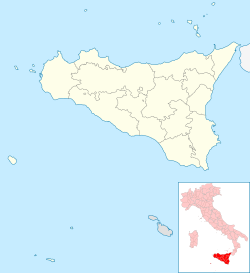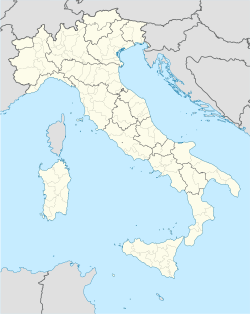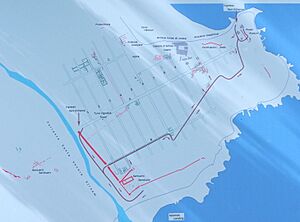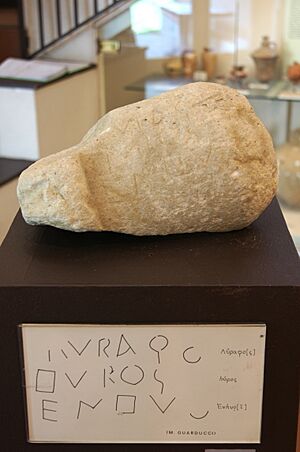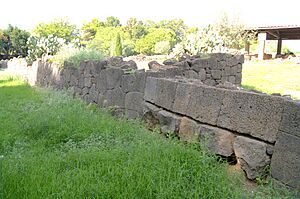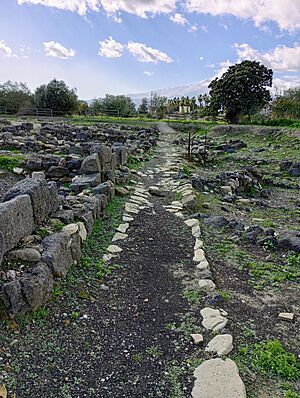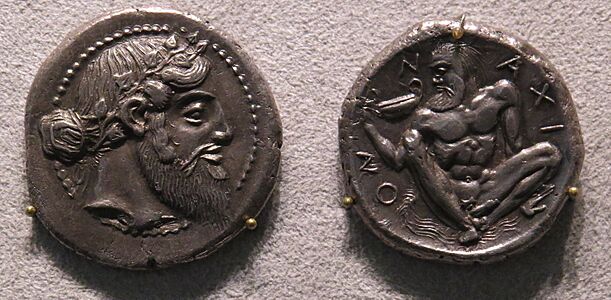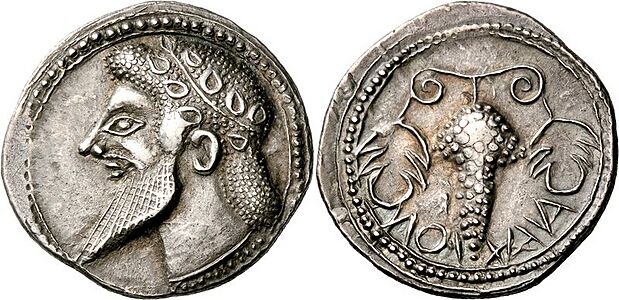Naxos (Sicily) facts for kids
|
Νάξος
|
|
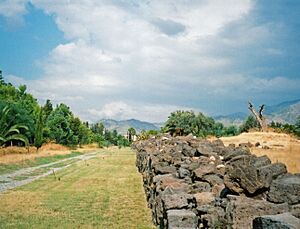
Walls of Naxos
|
|
| Location | Giardini Naxos, Province of Messina, Sicily, Italy |
|---|---|
| Coordinates | 37°49′23″N 15°16′24″E / 37.82306°N 15.27333°E |
| Type | Settlement |
| History | |
| Builder | Chalcidean colonists |
| Founded | 734 BC |
| Periods | Archaic Greece to Classical Greece |
Naxos was an ancient Greek city located in Sicily, an island that is now part of Italy. It was one of the very first Greek settlements in this area, known in ancient times as Magna Graecia. Today, you can find its remains near the modern town of Giardini Naxos on Sicily's east coast.
Much of the ancient city has not been built over, and parts of it have been carefully dug up by archaeologists in recent years. You can visit these ancient ruins, and there's also a museum nearby that displays many interesting items found at the site.
Contents
Where Was Naxos Located?
The city of Naxos was built on a low, rocky piece of land that sticks out into the sea. This area, now called Cape Schisò, was formed by an ancient lava flow. It was located just north of the Acesines stream, which is now known as the Alcantara River.
How Did Naxos Get Its Name?
The city of Naxos was named after the Greek island of Naxos. This is because the first people who settled here came from that island. In 1977, archaeologists found a special stone called a cippus (pronounced SIP-us) at a religious site west of the Santa Venera river. This stone had writing on it dedicated to the goddess Enyo. The writing style was from the 7th century BC and matched the unique writing of the Greek island of Naxos, confirming the connection.
The Story of Naxos
How Naxos Was Founded
Many ancient writers agree that Naxos was the oldest Greek colony in Sicily. It was founded around 734 or 735 BC. This was just one year before the famous city of Syracuse was established. The first settlers came from the Greek island of Naxos and from Chalcis in Euboea. Some people from Ionia also joined them.
A leader named Theocles (or Thucles) is often credited as the founder of the city. He was said to be from Athens. However, the historian Thucydides described Naxos as mainly a colony from Chalcis. It seems that Naxos was generally seen as a Chalcidic city later on.
To remember Naxos as the very first Greek settlement in Sicily, an altar was built outside the town. It was dedicated to Apollo Archegetes, who was seen as the divine protector of the colony. Even after Naxos was destroyed, people continued a tradition: any envoys (special messengers) traveling to or from Greece for sacred missions would offer sacrifices at this altar.
The new colony of Naxos grew quickly. Just six years after it was founded, the people of Naxos were able to send out new settlers. These settlers founded the city of Leontini (modern Lentini) in 730 BC. Soon after, they also founded Catana. Theocles himself became the "Oekist" (the recognized founder) of Leontini. While some ancient writers say Naxos also helped found Zancle (modern Messina), it was definitely a Chalcidic colony, so some Naxians likely joined in. Another colony of Naxos, Callipolis, also existed but disappeared early on.
Even with this early success, we don't have much information about Naxos's very early history. However, archaeological digs show that the city walls were built around the mid-6th century BC.
Naxos in the 5th Century BC
The 5th century BC was a very busy and often difficult time for Naxos, as shown by archaeological discoveries.
- Changes in Control: Around 492 BC, the city was attacked and taken by Hippocrates of Gela, a powerful ruler from Gela. Later, it came under the control of Gelon of Syracuse and then his brother Hieron of Syracuse. In 476 BC, Hieron wanted to make his own power stronger. He moved the people of Naxos and Catana to Leontini. Then, he brought new settlers from other places to Naxos and Catana.
- Rebuilding the City: Around 470 BC, Naxos was completely rebuilt, probably by Hieron. The old city was leveled, and a new, more organized city plan was laid out. Archaeologists have found two different city layouts built on top of each other.
- Return to Old Citizens: After Hieron's death, the original citizens of Naxos were allowed to return to their city around 461 BC.
- Alliances: From then on, the three Chalcidic cities—Naxos, Leontini, and Catana—usually stayed friends. They often allied against Syracuse and other Doric cities in Sicily. For example, in 427 BC, when Leontini was in trouble with Syracuse, Naxos helped them.
- Joining Athens: When the first Athenian expedition came to Sicily, Naxians quickly joined their side. They likely joined the Athenians because they were enemies with their neighbors in Messana. In 425 BC, Messana attacked Naxos by land and sea, but the Naxians fought them off bravely and caused heavy losses to the attackers.
- The Great Athenian Expedition: During the large Athenian expedition to Sicily in 415 BC, Naxos immediately became an ally. They provided supplies and welcomed the Athenians into their city. Naxos was the first place the Athenian fleet stopped after crossing the straits. The historians say that Naxos and Catana were the only Greek cities in Sicily that sided with the Athenians.
- Destruction: After the Athenians lost their expedition, the Chalcidic cities faced problems with Syracuse. However, a new threat from the Carthaginians in 409 BC made everyone pause their fighting. This saved Naxos for a short time. But in 403 BC, Dionysius I of Syracuse, a powerful ruler of Syracuse, decided to attack the Chalcidic cities. He took control of Naxos through betrayal. He sold all the people of Naxos into slavery and destroyed the city's walls and buildings. He then gave the land to the nearby Siculi people.
The Rise of Tauromenium
After Naxos was destroyed, the Siculi people soon built a new settlement on a nearby mountain called Mount Taurus. This settlement slowly grew into the city of Tauromenium, which is modern Taormina. This happened around 396 BC.
The people who used to live in Naxos and Catana had been forced to leave their homes. In 358 BC, a man named Andromachus gathered these Naxian exiles from all over Sicily. He settled them in Tauromenium, which then became the new city that carried on the legacy of ancient Naxos. This is why some ancient writers mistakenly said Tauromenium was formerly called Naxos. The new city quickly became important.
The original site of Naxos itself was never really lived in again in ancient times. However, the altar and shrine of Apollo Archegetes, which marked the spot where Naxos had stood, were still remembered and mentioned in later wars.
Roman Times
Later, during the Roman period, some new buildings were constructed over the Greek ruins. These included a mansio (a type of inn or resting place) and streets that followed the general layout of the ancient Greek roads.
What You Can See at the Site Today
- City Walls: You can still see parts of the city walls on the south side of the site. These walls were built in the mid-6th century BC using a strong building method called "Cyclopean polygonal technique." They were very tall, up to 8 meters high, with the bottom 2 meters made of stone and the upper part made of mud bricks.
- City Layout: As mentioned, the city was completely rebuilt around 470 BC, likely by Hieron I of Syracuse. This new city had a very organized, grid-like street plan, different from the first city. The original city was leveled and lies beneath this later one. Only some sacred areas, temples, and the shipyard were kept in their original positions. This city plan is one of the best examples of its kind in the western world. You can see square bases, possibly altars, at the southeast corner of each crossroads.
- Shipyard: The front of the shipyard complex shows that today's sandy beach is about 180–190 meters further out than the coastline was in the 5th century BC. It also suggests that the sea level was about 2 meters higher back then.
Ancient Coins of Naxos
The coins made in Naxos are known for their beautiful craftsmanship. Most of them were made between 460 BC and 403 BC. This was probably the most successful time in the city's history.
-
A Drachm coin minted in Naxos from the 6th century BC.
See also


